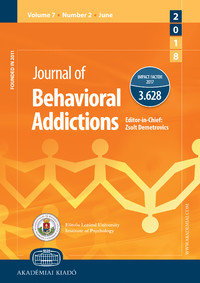Smartphone use motivation and problematic smartphone use in a national representative sample of Chinese adolescents: The mediating roles of smartphone use time for various activities
Smartphone use motivation and problematic smartphone use in a national representative sample of Chinese adolescents: The mediating roles of smartphone use time for various activities
Author(s): Haoran Meng, Hongjian Cao, Ruining Hao, Nan Zhou, Yue Liang, Lulu Wu, Lianjiang Jiang, Rongzi Ma, Beilei LiSubject(s): Behaviorism
Published by: Akadémiai Kiadó
Keywords: problematic smartphone use; smartphone use motivation; smartphone use time; Chinese adolescents; national representative sample
Summary/Abstract: Background and aims. Previous studies on smartphone use motivation (SUM) and problematic smartphone use (PSU) have been limited in the utilization of regional samples of emerging adults (e.g., college students) and also in the foci on the direct association between SUM and PSU. To address such gaps, using data from a large, national representative sample of Chinese young adolescents and their parents this study examined the associations between adolescents' various types of SUM and their PSU, and also tested the potential mediating roles of smartphone use time (SUT) that adolescents spent on various activities in such associations. Methods. A nationwide representative sample of 8,261 Chinese adolescents (Mage = 12.86 years old, SD = 1.76; 42.6% females) and their parents (49% mothers) participated in this survey study. Results. Instrumental SUM (i.e., to expand knowledge or acquire information) was associated negatively with PSU via longer SUT spent on learning and shorter SUT spent on entertainment and communication. Self-expression SUM (i.e., to gain acceptance and recognition of others by maintaining or improving self-images) was associated with longer SUT spent on both learning and entertainment, which, in turn, predicted lower and higher levels of PSU, respectively. Last, hedonic SUM (i.e., to gain pleasure) was associated positively with PSU via longer SUT spent on entertainment and communication. Discussion. These findings contribute to the literature by adding greater specificity in our understanding of the implications of SUM and SUT in the etiology of PSU during the critical life stage of adolescence in a Chinese cultural context.
Journal: Journal of Behavioral Addictions
- Issue Year: 9/2020
- Issue No: 1
- Page Range: 163-174
- Page Count: 12
- Language: English

